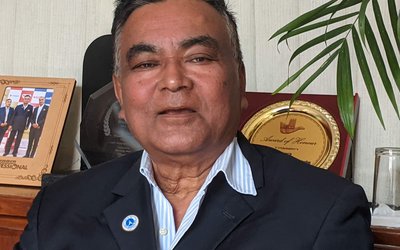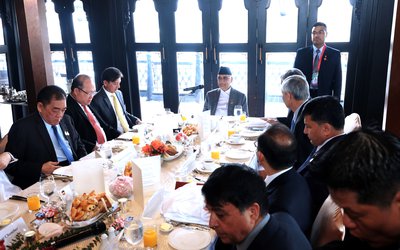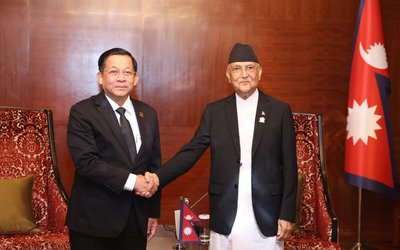More on Interview




As Nepal has been passing through a very crucial phase of politics, the country’s tourism sector, which rebounded after Nepal Tourism Year 2011, appears bound to suffer. With his long experience of working in Nepal’s tourism sector, ADITYA BARAL, director and spokesperson of Nepal Tourism Board, spoke to NEW SPOTLIGHT on various issues. Excerpts:
After several political upheavals, a new lease of life was breathed into the tourism sector by Nepal Tourism Year 2011, but the current gloomy political scenario is again hindering its growth. What can be done to address this issue?
More than the government, the people of Nepal should try to comprehend tourism and tourists in newly emerging perspective. Gone are the days when the government's priorities, programs and policies used to intervene much on tourist's psyche. Days have changed. Today's tourism has turned bold to encounter the turmoil. Therefore, as long as we keep this notion and sanctity of tourist's right, tourists will never hate Nepal. We have to learn to honor their paid independence.
Tourist arrival data of the month of May this year speaks volumes about this trend. But it might take a heavy toll if the prevalent situation persists. Since the human factor is the biggest advantage we have, as long as we treat tourists as we used to without losing sanity, tourists keep on coming to Nepal unabated.
What is the status of the Visit Lumbini (VTY) year 2012? Will the number of tourist arrivals this year surpass the number of the last year?
It is our utmost responsibility to promote any tourism campaign announced by the government within the ambit bestowed on us. Even without VTY, we cannot forget Lumbini-one of the world's sacred places. Looking into the Buddhism aspect of the tourism potential, NTB, with or without VTY, has been consistently promoting Lumbini as a major cultural tourism product. It has not left its promotional drive in the different national and international travel marts. So far, talking about its status, promotion has not transformed into national campaigns due to institutional incoherence and lack of precise job definition. If things remain the same as in the past year, of course, this year will surpass the number of the last year. However, everything is contingent upon Nepal's and Nepalese people’s behavioral manifestations.
How does the future of tourism look in the present context?
The future of tourism has never been bad in Nepal, and will not be so as long as we have high mountains, mosaic of cultural heritage and, most importantly, the SMILING people. However, if we lose our sanity, our smile, our graciousness, or our affability, no one can bring tourists to Nepal. I am quite optimistic about the future of tourism in Nepal. From the government's perspective, we should be able to unleash pro-business policies and the public should treat tourists as guests, as in the past.
Experts say that the promotional campaigns for NTY 2011 have made positive impacts although they were started late. How much has Nepal actually gained from the promotion campaigns for NTY 2011?
It is difficult to assess the impact of promotional campaigns in black and white, especially in figures like we do in consumer goods. But looking at the arrivals, we have to admit that we have gained substantially from the promotions, people's orientations and education. We cannot ignore the fact that Nepal has been promoted hugely by word of mouth especially by foreign mountaineers and mountain lovers. They are the dedicated communities who come to Nepal even though their country issues negative travel advisories against Nepal. NTY has given a bold message, that if we all (people) wish and do all works in collaboration, the mission is not impossible. Nothing is impossible. More than objective, we gained an immense knowledge subjectively.
From the tourism arrival statistics of the current year, it is seen that the numbers of Chinese and Indian tourists have gone up significantly. What can be done to maintain or even increase the numbers of tourists from China and India?
After opening up its outbound market, Nepal was one of few destinations that China chose to send its tourists. However, due to lack of good air connectivity with competitive price, Nepal has not so far capitalized the potentiality of Chinese market. As far as the Chinese tourists are concerned, it all depends on the policy of the Chinese government. Outbound tourists’ movement is still controlled by the government. So promotional and marketing tools have little influence over the tourists. The government to government negotiations and relations can enhance the tourist arrivals from China. The Indian market is driven by the private sector (market forces). It means it is difficult to penetrate the Indian market as you have to deal with individuals pampered by other destinations with incentives and competitive prices. But once you rope them into business, you get the dividend in the long run.
The number of European and American tourists have not increased that much and Nepal’s tourism sector is mainly dependent only on the tourists from the two neighbors. What are the reasons for this and what can be done to improve the scenario?
Tourist arrivals from Europe and America are not as bad as you portrayed. Till May, we have had 18.7% increase from Europe and 13.4% increase from America. The percentages could be higher if a few detrimental factors had not made people difficult to travel. One of the main reasons is resource crunch due to recession in Europe and America. Another is that the airfare from these continents to Nepal is higher than travelling to other destinations that are closer to Nepal. As people with the disposable amount of money for travelling in Europe and America are older people, they tend to seek leisure travel. So this segment has not been so much interested in our kind of adventure tourism. So we are losing this segment from affluent countries, that we call grey tourism.
In the context of growing political unrest and deteriorating social harmony, how can we promote tourism in Nepal?
As stated earlier, the social harmony is maintained and disturbed by the people. People are the catalysts on turning or tuning this affair. Hence, if we treat tourists through political spectacle, then, let us stop our promotion drives. However, if we separate politics from tourism, then we can unleash ample opportunities in tourism. We consider tourism as an opportunity in crisis. We never lagged behind in receiving tourists even during the height of insurgency marked by strikes and political chaos. We were never discouraged from our onus to safeguard the interest of tourists. Political instability has become a part of our life, and we cannot shy away from this fact. We have to live with our reality, not deviate from our hospitality and promote Nepal accordingly.
Nepal’s tourism sector survives because of repeat visitors. Given Nepal’s growing political instability, what do you suggest to maintain them?
Surprisingly, Nepal is one of the few tourist destinations in the world that witness a large number of tourists coming there repeatedly despite all inconveniences that they may encounter during their tour in Nepal. The reason, as our research has found, is that it’s not just because of the diverse tourism products that attract them repeatedly to Nepal but because of the ever-smiling and hospitable people. Despite our political or social difference, we have to be cordial to the tourists who come to Nepal, and respect their freedom of movement. This is the only mantra that works in this kind of situation.





